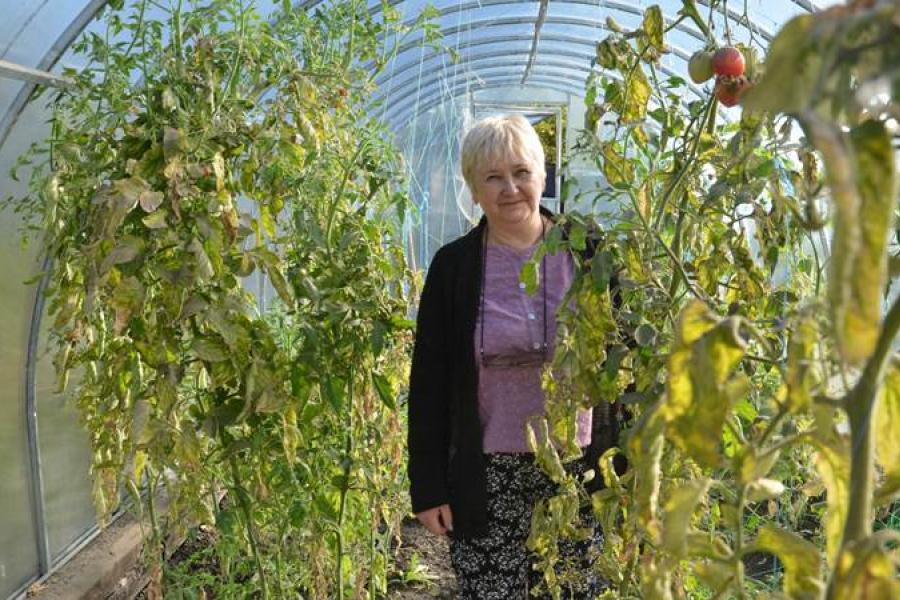Helping women fulfil potential in rural Ukraine can make agriculture sector more efficient
13 July 2021
- For the first time, FAO assessed Ukraine’s agriculture and rural development sector from a gender perspective

Caption: A woman in Donetsk oblast, Ukraine, watching over tomatoes that she grows for her family.
Photo: © FAO/Viktoriia Mykhalchuk
As elsewhere in the world, women in Ukraine represent a large proportion of the agricultural labour force and the majority of food producers, and thus play key roles in managing natural resources and promoting the well-being of their families.
To explore and analyse gender issues in agriculture and food security, the Food and Agriculture Organization of the United Nations (FAO) has developed the first Country Gender Assessment for Ukraine,. The report – part of FAO’s Country Gender Assessment series, and whose full title is ‘National Gender Profile of Agriculture and Rural Livelihoods (Ukraine)’ – aims to serve policymakers and practitioners engaged in the formulation and implementation of agriculture policies and programmes, researchers and analysts, civil society actors, and other partners.
The report acknowledges women’s role in food systems and rural development, yet it also points out their unequal access to land and other assets and resources, which limits their economic opportunities and puts them at risk of being left behind. Based on these findings, the report provides recommendations on how to address gender inequalities for increased agricultural productivity and food security, and sustainable rural development.
Greater agricultural productivity, food security and rural livelihoods, says the report, cannot be achieved without recognising the distinct and complementary roles of women and men, and ensuring social and economic equality for both groups.
“The report contributes to the existing knowledge base about gender equality in the country, by bringing together gender statistics and experts’ opinions, but also serving as an advocacy tool to provide greater visibility to rural women’s contribution to agricultural productivity and food security,” said Mara Lopes, FAO Ukraine Head of Office. “Women and girls are critical agents in the fight against rural poverty and food insecurity. Supporting them in reaching their full potential will enable agricultural and rural development processes to be more effective.”
“The FAO report on Gender, Agriculture and Rural Development is an in-depth and comprehensive document covering gender issues in the context of different areas of women's and men's lives, including participation in decision-making, freedom from violence, the impact of climate change, access to resources such as land, water energy, education, health and more,” added Kateryna Levchenko, Government Commissioner for Gender Equality Policy. “This makes it a relevant source of information for all a wide range of users”.
However, the report finds that rural women in Ukraine are limited in their capacity to contribute to agricultural production and take advantage of new opportunities, being concentrated in informal jobs and overloaded by multiple responsibilities. These include unpaid informal work on family farms, daily housework, and caring for children and other family members. Despite the heavy workload, their effort is often invisible and receives little recognition or economic or social reward.
“Since the outbreak of COVID-19, many women across the region find themselves in an even more disadvantaged situation, as evidence points to increased rates of domestic violence and longer hours of care work due to the widespread closure of schools,” said Dono Abdurazakova, FAO Senior Gender and Social Protection Advisor. “Rural women with disabilities, women from ethnic minority groups such as Roma women, women who have been internally displaced, and many more, suffer from multiple vulnerabilities.”
One in every six people employed in Ukraine works in agriculture, forestry and fisheries. The report reveals that specific job types within that sector tend to fall into either “female” or “male” occupation categories.
Men represent 71 percent of all formal employees in agriculture, forestry and fisheries, whereas women in the same sector tend to work informally. Women make up 56 percent of migrant labour in Ukraine as a whole, and 58 percent of migrant labour in rural areas. Men are more likely to migrate abroad, while women tend to migrate internally.
Unsurprisingly, only 20 percent of farming enterprises in Ukraine are headed by women. What is perhaps more surprising is that women generally undertake manual labour, such as cultivation, planting, weeding, and harvesting perishable vegetables, berries and herbs. Men, meanwhile, tend to undertake mechanised work such as tilling, ploughing and planting fodder crops, harvesting grain and corn (with combine harvesters), and transporting products to markets.
Men are more likely to engage in large-scale crop production (wheat, corn, sunflowers), while women typically focus on horticulture and herbs. The tendency towards distinct tasks is repeated within the livestock sector, with women active in dairy production and work associated with milking and care of cows, and men usually responsible for transportation and mechanised labour.
The report also goes into some detail on food, health and nutrition, broken down by the female and male experience in Ukraine. In terms of life expectancy, Ukrainian women live on average 10 years longer than men, and that gap is even more pronounced in rural communities (76.2 years compared with 65.6 years for men in 2019). This is a pattern reflected across all post-Soviet countries. In Western Europe, by comparison, female life expectancy exceeds that of their male counterparts by just five years.
Read online: http://www.fao.org/europe/news/detail-news/en/c/1402339/
LINKS Report: National Gender Profile of Agriculture and Rural Livelihoods (Ukraine) Cutting food waste while improving food security and environment in Ukraine Chicken breeding under shelling Country gender assessment series Gender and Rural Development in Eastern Europe and Central Asia: Key Issues FAO Regional gender strategy for Europe and Central Asia, 2019-2022 |
|
Journalists & editors: |







